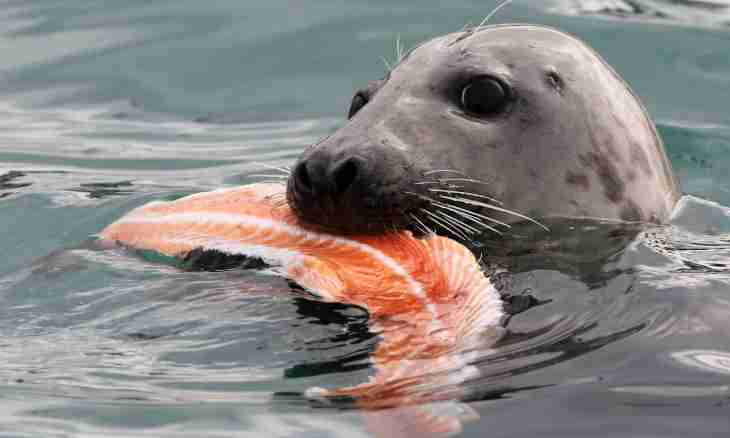The Baikal seals are animals unique, speaking to language of science, endemic. This species of a freshwater seal lives only in the water area of the deepest and ancient lake of the planet, in the purest waters of Baikal.
The schedule of life of a seal to genius is simple: if she does not sleep under water until there is enough oxygen in lungs, does not idle on coastal stones, so hunts, slowly plowing the possession in search of food. Favourite delicacy of a seal – crustaceans, mollusks and a viviparous small fish a golomyanka. They as if are created for each other, and the golomyanka is registered only on Baikal. And here the omul, so popular with tourists, not really attracts a seal, – still it is necessary to catch up with him. But if suddenly on its way the fishing nets filled by this small fish before such temptation meet the cunning will not resist and will organize to itself a stomach celebration, having left fishermen with a nose. Sometimes greed ruins monkeys: they get confused in networks, becoming an easy mark.
The healthy seal has all symptoms of obesity, fat protects from overcooling and damages, allows to keep easily on a water surface and helps to have hungry times.
Despite the impressive sizes (the adult seal can weigh from 50 to 120 kg), disappearing from danger, she nevertheless is capable to show improbable maneuverability and to gather considerable speeds, to 25 km/h. A serious threat for these animals is posed by poachers who in a pursuit of silvery fur do not shun to violate the law.
The Baikal seals at the end of winter – the beginning of spring when in their family the replenishment is expected are most vulnerable. Annually at this time on the snow-covered surface of the lake of a female, careful mothers, prepare the closed ice hole for future posterity with an outlet inside through which the shelter is reported with water. Such openings of a seal are always made in winter time, claws breaking off ice that everyone half an hour to rise to the surface and to resupply oxygen.
In this simple shelter to a baby seal, quite so call the newborn baby, warmly and safely: birds of prey, on open space capable to peck, will not reach it here, maternal milk will allow a cub to get stronger and stock up with a fat, and walls of a den will keep comfortable temperature inside. Almost all the time it is under supervision of single mother who leaves only for hunting. The father in life of family of participation does not accept, playing a role of "bull-osemenitelya".
Coming into the own, the spring can bring dangers. The ice shelter begins to collapse under sunshine and kumutkan that in Evenki is translated as "a seal cub", for the first time creeps out on light, appearing in the face of the world, unfamiliar for it. On this case the nature provided only one security measure – snow-white color of a fur coat for masking on snow. But unless it will save from the poachers adjusted by thirst of a profit? Looking in eyes to these little, touching and defenseless beings, it is difficult to present that there are hands capable to bring bludgeons over their heads. This weapon is most often used for a seal face – any other it is possible to damage valuable fur.
Long since locals ate seal meat. The gentle meat of hubunok, monthly cubs which is tasting like meat of a chicken was especially appreciated. Fish smack it is deprived, all their menu consists of mother's milk. Fur is nerpit is more senior, the teenagers who endured the first molt in a den or already on ice floes in the period of an ice drift went for production of clothes, high fur boots, mittens. In process of growing young seals, mastering water elements, passed to a fish diet. Their meat got characteristic fish began to smell and ceased to be appreciated. Adult individuals attracted only with fat with which filled lamps and used with the medicinal purposes.
Till 80th years of the last century the industrial hunting for the Baikal seal was allowed. This subject in the creativity was reflected by the poet Yevgeny Yevtushenko, having written the shrill "Ballad about seals". Now catching of the Baikal seal is officially forbidden: the mammal is depicted on pages of the Red List as an endangered species.
On March 15 the whole world celebrates the Day of protection of baby seals, and on May 25 a similar festival, Day of protection a nerpenka, passes in the Irkutsk region and Buryatia. For the purpose of the education and drawing attention to environmental problems concerning seals stage demonstrations, photo exhibitions, actions, flashmobs.
Perhaps, such measures will help to keep this unique inhabitant of the lake, one of the most important links of the Baikal ecosystem.

